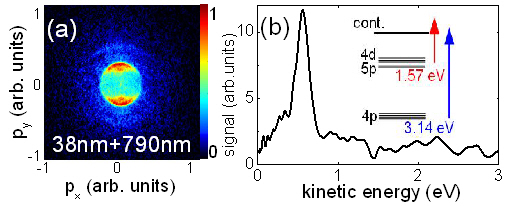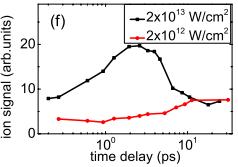The generation of a large number of charges in a cluster by an intense pulse of light can lead to the formation of a transient nanoplasm consisting of free electrons and ions. In the past, fascinating processes have already been observed in nanoplasmas, e.g. nuclear fusion or even the generation of neutral atoms with very high kinetic energies. While nanoplasmas are routinely generated during the interaction of clusters with intense XUV pulses from free-electron lasers, a detailed understanding of the processes within the plasma is challenging. Theoretical models have predicted that most of the electrons in the cluster remain trapped and eventually recombine with ions, so that both electrons and ions can not be observed in ordinary experiments. However, an experimental study of these dynamics is extremely important because the processes in clusters are complex and diverse, and their detailed prediction is difficult. A Promising Path to a Better Understanding of the Different Mechanisms Nanoplasmas is the development of time-resolved experiments. In this context, intensive sources of higher harmonic generation (HHG) are particularly interesting, which can generate light pulses down to the attosecond range. These laboratory-scale XUV sources make it easy to perform pump-probe experiments on clusters and greatly enhance the ability to understand cluster dynamics.
Freedom of electrons only lasts for a short time
Fig. 1 (a) Two-dimensional pulse imaging of electrons showing the momentum distribution of the emitted electrons in parallel (vertical) and vertical (horizontal) directions to the XUV / NIR laser polarization direction, after XUV ionization and NIR sample pulse on average 3500 size argon clusters atoms. The ring structure corresponds to the ionization of excited atoms by the NIR pulse. (b) The corresponding kinetic energy spectrum shows a maximum at an energy of 0.6 eV, which results from the NIR single-photon ionization of the 4d and 5p excited states in argon.
In an international collaboration led by researchers from the Max Born Institute, the first pump-probe experiment was performed on clusters with an intense HHG source. In the current issue of Physical Review Letters 112.253401, (2014), Bernd Schütte, Marc Vrakking, Arnaud Rouzée and their colleagues Filippo Campi from the University of Lund and Mathias Arbeiter and Thomas Fennel from the University of Rostock the results of these investigations. The development of a Reionization of Excited Atoms from Recombination (REAR) technique allows for the first time information on charge states prior to recombination. With the help of probe pulses in the near-infrared (NIR) region, a surprisingly large generation of excited atoms has been observed, and it has been shown that these atoms originate from recombination processes between electrons and ions. It has been demonstrated that nanoprocessed electrons produced by photoionization are quasi-free for only a short period of up to 10 picoseconds before undergoing recombination processes with surrounding ions. More information about these mechanisms has been obtained by creating special clusters consisting of a xenon core and an argon shell. These studies have shown that recombination occurs preferentially in the xenon nucleus of the cluster. It has been demonstrated that the wavelength of the ionizing laser pulse interacting with the cluster is not important: the generation of excited atoms from recombination processes was also observed when NIR or blue light was used instead of the XUV pulses. This shows that current findings have general implications for the explanation of previous experiments conducted in different wavelength ranges. Furthermore, the REAR technique enabled the cluster to be tracked down to the nanosecond range.
Fig. 2 Time-resolved Xe+ ion yield after XUV ionization of mixed clusters consisting of a xenon core and an argon shell. An NIR pulse at two different intensities is used for sampling. At an intensity of 2x1013 W/cm2, the ion yield has a maximum with a delay time of about 3 picoseconds due to a well-known plasma resonance effect. At the lower intensity of 2x1012 W/cm2, the signal increases monotonically during the first 10 picoseconds, which is identified as the time scale of electron-ion recombination.
Our results show the remarkable versatility of intense HHG pulses for the study of dynamic processes in clusters. In the future, the study of other extended systems such as biomolecules will benefit from the availability of these laboratory scale XUV light sources.
Search publications of MBI
Publications since 2025

